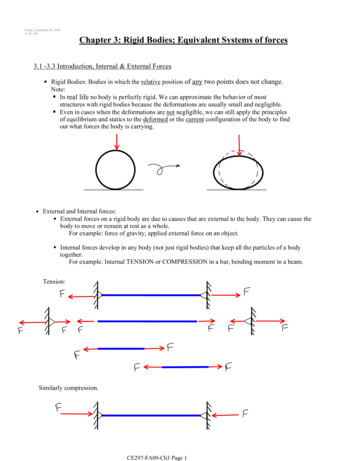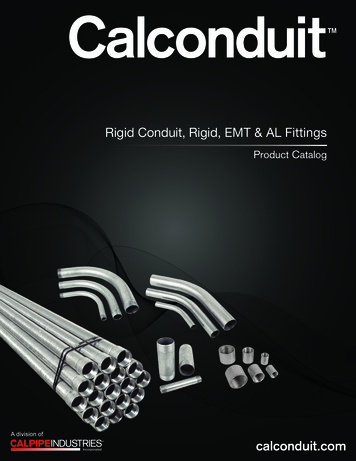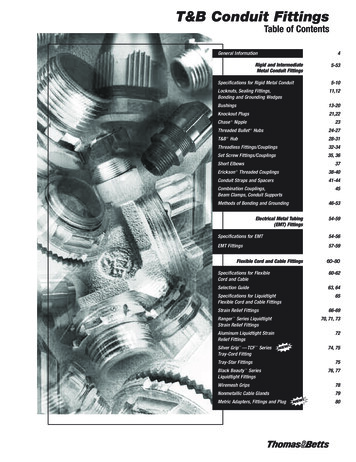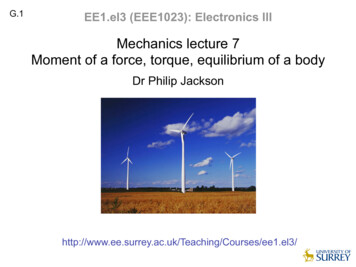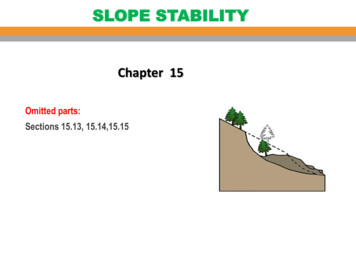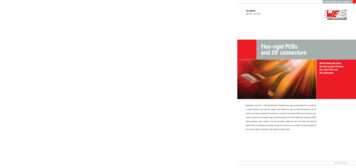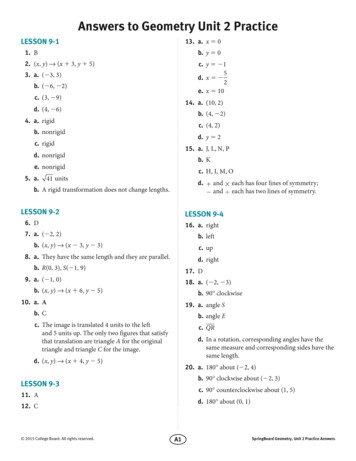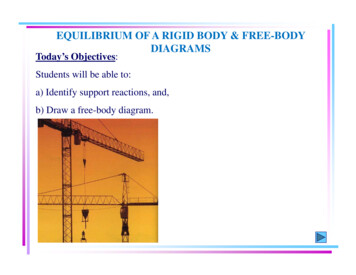
Transcription
EQUILIBRIUM OF A RIGID BODY & FREE-BODYDIAGRAMSToday’s Objectives:Students will be able to:a) Identify support reactions, and,b) Draw a free-body diagram.
CONDITIONS FOR RIGID-BODY EQUILIBRIUM( Section 5.1)Forces on a particleIn contrast to the forces on a particle, theforces on a rigid-body are not usuallyconcurrent and may cause rotation of thebody (due to the moments created by theforces).For a rigid body to be in equilibrium, thenet force as well as the net momentabout any arbitrary point O must beequal to zero. F 0 and MO 0Forces on a rigid body
THE PROCESS OF SOLVING RIGID BODYEQUILIBRIUM PROBLEMSFor analyzing an actual physical system, first we need to create anidealized model. The object separate from its surroundings.Then we need to draw a free-body diagram showing all the external(active and reactive) forces. (Hard part is support reactions)Finally, we need to apply the equations of equilibrium to solve forany unknowns.
FREE-BODY DIAGRAMS(Section 5.2)Idealized modelFree-body diagram1. Draw an outlined shape. Imagine the body to be isolatedor cut “free” from its constraints and draw its outlinedshape.2. Show all the external forces and couple moments. Thesetypically include: a) applied loads, b) the weight of thebody, and c) support reactions (can be difficult).
FREE-BODY DIAGRAMS(continued)Idealized modelFree-body diagram3. Label loads and dimensions: All known forces andcouple moments should be labeled with theirmagnitudes and directions. For the unknown forcesand couple moments, use letters like Ax, Ay, MA, etc.Indicate any necessary dimensions.
SUPPORT REACTIONS IN 2-DA few examples are shown above. Other supportreactions are given in your textbook (in Table 5-1). If a support prevents translation of a body in a direction b,then a force Fb is developed on the body in the oppositedirection. If rotation is prevented in direction b, a couple momentMb is exerted on the body. (Review 5-1)
CONCEPT QUIZ1. The beam and the cable (with a frictionless pulley at D) support an80 kg load at C. In a FBD of only the beam, there are how manyunknowns?1) 2 forces and 1 couple moment2) 3 forces and 1 couple moment3) 3 forces4) 4 forces
CONCEPT QUIZ2. If the directions of the force and the couple moments arereversed, then what will happen to the beam?A)B)C)D)The beam will lift from A.The beam will lift at B.The beam will be restrained.The beam will break.
ATTENTION QUIZ1. Internal forces are not shown on a free-body diagram because theinternal forces are . (Choose the most appropriate answer.)A) equal to zeroB) equal and opposite and they do notaffect the calculationsC) negligibly smallD) not important2. How many unknown support reactionsare there in this problem?1)2 forces and 2 couple moments2)1 force and 2 couple moments3)3 forces4)3 forces and 1 couple moment
IMPORTANT NOTEA single bearing or hinge can prevent rotation by providing aresistive couple moment. However, it is usually preferred to usetwo or more properly aligned bearings or hinges. Thus, in thesecases, only force reactions are generated and there are nomoment reactions created.
Reaction Couple MomentTo support weight ofsign, hinge exertsupward force.HyWReactioncoupleWeight twists hinge.So wall exerts reactionforce distribution. Thenet force is zero butthere is a non-zerocouple moment.
Properly Aligned SupportsTHyHxWA properly alignedsupport, preventsthe twisting of thehinge.The reaction coupleof the hinge isnegligible.
Improperly Aligned SupportsHyHxWTAn improperlyaligned supportdoes nothing toprevent thetwisting of thehinge or makesthe twistingworse.
Are the Supports Properly Aligned? The problem says so. Are there more unknowns thanequations? If we drop the reaction couplemoments, do we have enoughequations?
FREE-BODY DIAGRAMS (Section 5.2) 1. Draw an outlined shape. Imagine the body to be isolated or cut "free" from its constraints and draw its outlined shape. 2. Show all the external forces and couple moments. These typically include: a) applied loads, b) the weight of the body, and c) support reactions (can be difficult).
